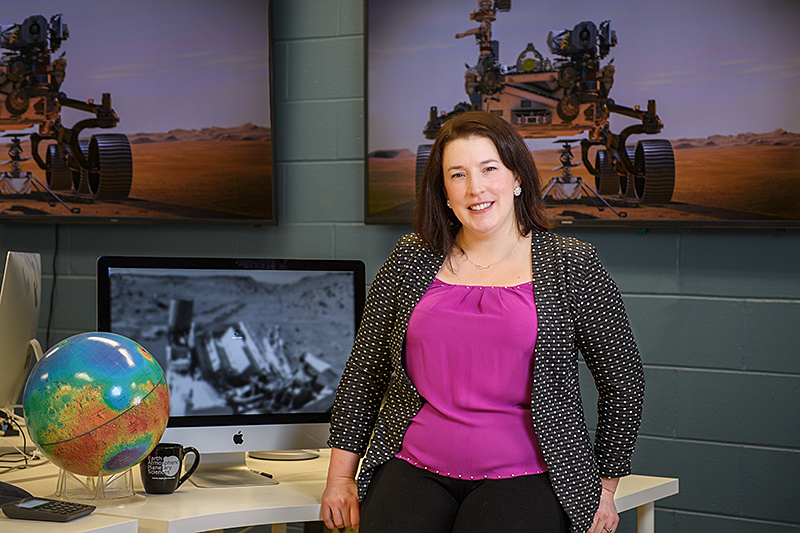February 15, 2021
Upcoming Mars rover landing marks latest step in researching the red planet
WEST LAFAYETTE, Ind. — The Mars Perseverance Rover will fly 300 million miles over almost seven months, but the seven minutes spent waiting to receive a radio signal confirming the rover has landed will seem like an eternity for scientists and researchers back on Earth.
That wait is dubbed the “seven minutes of terror” and Briony Horgan, Purdue University associate professor of planetary science in the College of Science, calls it the scariest moment of the mission.
“The rover descends in a plasma fireball through the Mars atmosphere and has to slow down from about 12,000 miles per hour to zero in about seven minutes, so it is a pretty scary endeavor,” said Horgan, who has played a key role in the mission, including leading research on the geology of the landing site. (Horgan talks about the seven minutes of terror.)
 Briony Horgan associate professor of planetary science, sits inside the Mars Rover Operations Center in Purdue’s Delon and Elizabeth Hampton Hall of Civil Engineering. Horgan and others will be on the edge of their seat for seven minutes as they wait for confirmation the Mars rover touched down safely. (Purdue University photo/Rebecca McElhoe)
Briony Horgan associate professor of planetary science, sits inside the Mars Rover Operations Center in Purdue’s Delon and Elizabeth Hampton Hall of Civil Engineering. Horgan and others will be on the edge of their seat for seven minutes as they wait for confirmation the Mars rover touched down safely. (Purdue University photo/Rebecca McElhoe)
The NASA rover Perseverance is estimated to touch down around 4 p.m. ET Thursday (Feb. 18) on the surface of Mars. Channels that will carry the live broadcast include:
In addition, Horgan will appear on a pre-landing livestream program on Vice News.
The rover will land in Jezero Crater, just north of the planet’s equator. The crater used to contain a lake and large river delta. Horgan led mineralogy research for the mission and her team’s important finding on the location contributed to the selection of Jezero Crater. She also is on the rover camera team that will be the scientific eyes for Perseverance.
Horgan’s research and a presentation led NASA to select the rover landing site.
For the six and a half months between launch and landing, Horgan and the Mars team have been working consistently on preparations for when the rover reaches the red planet. Plans are being made for where the rover will go and what it will do in the Jezero Crater, ranging from collecting samples to looking for ancient signs of life and understanding the planet’s geological processes.
Extremely detailed maps of the crater terrain will help make the decisions.
“This is a great opportunity for both me and my students to get involved with planning what the rover does day to day,” Horgan said. “We’re doing a lot of operations tests and working out the kinks in software, learning how to work together as a team.
“We’re really excited for the rover to hit the ground running but, hopefully, not hit it too hard.”
About Purdue University
Purdue University is a top public research institution developing practical solutions to today’s toughest challenges. Ranked the No. 6 Most Innovative University in the United States by U.S. News & World Report, Purdue delivers world-changing research and out-of-this-world discovery. Committed to hands-on and online, real-world learning, Purdue offers a transformative education to all. Committed to affordability and accessibility, Purdue has frozen tuition and most fees at 2012-13 levels, enabling more students than ever to graduate debt-free. See how Purdue never stops in the persistent pursuit of the next giant leap at https://purdue.edu/.
Writer, Media contact: Brian Huchel, 765-494-2084, bhuchel@purdue.edu
Source: Briony Horgan, briony@purdue.edu, @ironywithab
Journalists visiting campus: Journalists should follow Protect Purdue protocols and the following guidelines:
- Campus is open, but the number of people in spaces may be limited. We will be as accommodating as possible, but you may be asked to step out or report from another location.
- To enable access, particularly to campus buildings, we recommend you contact the Purdue News Service media contact listed on the release to let them know the nature of the visit and where you will be visiting. A News Service representative can facilitate safe access and may escort you on campus.
- Correctly wear face masks inside any campus building, and correctly wear face masks outdoors when social distancing of at least six feet is not possible.
Note to journalists: Photos and video of Briony Horgan as well as Mars images are available on Google Drive. Journalists visiting campus should follow visitor health guidelines.

